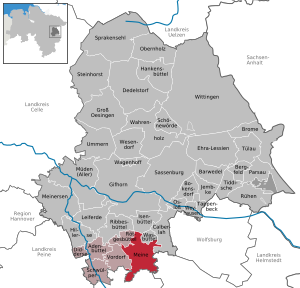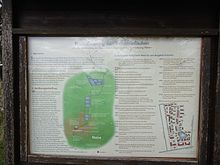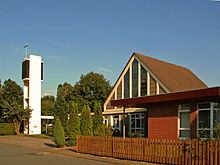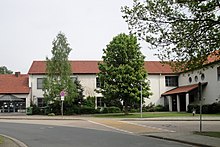My
| coat of arms | Germany map | |
|---|---|---|

|
Coordinates: 52 ° 23 ' N , 10 ° 32' E |
|
| Basic data | ||
| State : | Lower Saxony | |
| County : | Gifhorn | |
| Joint municipality : | Papenteich | |
| Height : | 79 m above sea level NHN | |
| Area : | 38.74 km 2 | |
| Residents: | 8639 (Dec. 31, 2019) | |
| Population density : | 223 inhabitants per km 2 | |
| Postal code : | 38527 | |
| Primaries : | 05304, 05307 | |
| License plate : | GF | |
| Community key : | 03 1 51 016 | |
| LOCODE : | DE 73K | |
| Community structure: | 8 districts | |
| Address of the municipal administration: |
Abbesbütteler Strasse 4 38527 Meine |
|
| Website : | ||
| Mayoress : | Ute Heinsohn-Buchmann ( SPD ) | |
| Location of the community of Meine in the Gifhorn district | ||
Mine is a municipality in the Gifhorn district in Lower Saxony . The village of Meine, the main town of this municipality, was first mentioned in a document in 1007, but is probably considerably older. Mine is the largest community and the administrative seat of the Papenteich joint community .
geography
Geographical location
Mine is located in eastern Lower Saxony on the way from Braunschweig to the Lüneburg Heath . The Mittelland Canal runs right through the municipality . There are hardly any hills in the area, but when the weather is clear you can see the Elm and Harz Mountains . Outside the villages there are fields, deciduous forests and a gravel and sand mining area near Abbesbüttel .
Neighboring communities
The community of Meine borders on the city of Braunschweig in the south. Other neighboring communities are Rötgesbüttel , Vordorf , Isenbüttel , Wasbüttel , Calberlah (all district of Gifhorn) and Lehr ( district of Helmstedt ). The cities of Braunschweig , Gifhorn and Wolfsburg are each around 10 kilometers from Meine.
Community structure
The community includes the districts of Meine (Kernort), Abbesbüttel , Bechtsbüttel , Wedelheine , Wedesbüttel , Grassel , Gravenhorst and Ohnhorst as well as the settlements Meinholz and Martinsbüttel . There is also a windmill with its own bus stop in the Feldmark between Meine and Abbesbüttel. The mill can also be found in the municipal coat of arms.
Within the core town of Meine, the western part is called Meinersand and the northern part is called Zellberg . According to Meibeyer, the name Zellberg is said to go back to a prehistoric burial mound that was formerly located there and which was later removed in the course of the agricultural use of the site.
In the Feldmark north of the village which lies Ortswüstung Smelke and southeast the Ortswüstung stack or Stabel . Far north of the village, just before Rötgesbüttel, are the Büchenteich, which is called Beukendiek in the village , and the Dingbänke . The name Dingbänke refers to an old, central open-air court and assembly place (Ding, Thing ) for the historic Gogräfschaft Papenteich. Halfway between Meine and Ohnhorst are the Meiner Ponds, an extensive pond area (former clarification ponds of the sugar factory) with a species-rich bird population (see below).
A laid out educational trail along an asphalt cycle path between the B 4 and the Mittelland Canal introduces those interested to the local flora with its vegetation and characteristics and provides useful information on signposted path stations.
history
Mine was first mentioned in 1007 as Meynum . However, it is believed that the place had been around for a long time at that time. In the opinion of the geographer Wolfgang Meibeyer , the founding of Meines is related to the subjugation of the Sachsenland by the Franks in the 8th century. At that time, several settlements were founded in the previously largely uninhabited northern forest . Oberbeck, on the other hand, assumes that the village was built at the beginning of the older clearing period (around the 6th or 7th century).
From the 11th century the place was a border place between the Diocese of Halberstadt and the Diocese of Hildesheim , the border of which ran west of the place.
The place has experienced a significant upswing in recent times as a result of the construction of the Papenteich zu Meine AG sugar beet factory in 1883.
20th century
The diary of the Protestant parish pastor Rudolf Gurland , published under the title "Invisible Church", reports on the events in Meine between 1930 and 1939 . On his father's side of Jewish descent, he was persecuted by the Bolsheviks after the October Revolution in the Baltic States and subjected to Nazi intimidation attempts in Lower Saxony after 1933 .
In the final phase of World War II , there was a result of increased air raids on the nearby industrial city of Braunschweig also bombing in and around the place My.
On the night of August 13-14, 1944, Meine experienced its heaviest bomb attack . The aim of the attack was Reichsstraße 4 (today: Bundesstraße 4 ) and the connection of the Reichsbahn from Braunschweig to Gifhorn. As a result of the attack, two buildings on the main street were completely destroyed by the bombs. Reichsstraße 4 and the railway connection were badly hit and were impassable for several days. Mine was occupied by US troops in April 1945 and later belonged to the British zone of occupation .
21st century
In 2009, the foundation stone for a private was in my on the premises of the former elementary and secondary school gymnasium in ownership of the Evangelical Lutheran Church of Hanover set, the Philipp-Melanchthon-Gymnasium, which opened on August 18, 2011th The founding school director is senior studies director Stephan Oelker . In January 2016, a new community center was inaugurated - immediately adjacent to the Philipp Melanchthon Grammar School to the north. Meanwhile, it is disputed whether the old community center in need of renovation falls into the economic ownership of the community of Meine or the district of Gifhorn.
Incorporations
On March 1, 1974, the communities Abbesbüttel, Bechtsbüttel, Grassel, Gravenhorst, Ohnhorst, Wedelheine and Wedesbüttel were incorporated.
Population development
On December 31, 2006, 8,135 people lived in the Meine community, more than half of them in Meine. The population development in historical times is documented separately for all sub-locations. In the district of Meine, the numbers developed as follows:
|
|
| year | Residents |
|---|---|
| 2010 | 8179 |
| 2016 | 8610 |
| 2017 | 8648 |
The large population growth after the Second World War is mainly due to the influx of displaced persons and refugees . In 1950, 696 of the 1712 inhabitants were displaced and immigrated. The further increase in population in the late 20th century and in the early 21st century resulted from the economically attractive location in the area surrounding Braunschweig and Wolfsburg, which led to the designation of numerous new building areas. One and two-family houses are predominant. The "new town center" on Hauptstrasse and Zuckerallee with numerous shops and service providers as well as new residential buildings for several hundred people was built at the end of the 1990s on the former site of the sugar factory.
politics
advice
Since the local election on September 10, 2006 ( turnout of 59.2%), the council of the Meine community has been composed as follows:
- CDU 11 seats - 47.0%
- SPD 9 seats - 38.8%
- Alliance 90 / The Greens 1 seat - 6.5%
- FDP 1 seat - 2.9%
- UWG 1 seat - 2.8%
The SPD, Greens, FDP and UWG formed a joint group in the municipal council for the 2006-2011 electoral period, which according to Lower Saxony municipal law has a status similar to that of a parliamentary group.
The local election on September 11, 2011 ( voter turnout of 57.98%) had the following result with clear gains for the SPD and the Greens:
- SPD 11 seats - 49.49%
- CDU 7 seats - 29.98%
- Alliance 90 / The Greens 3 seats - 12.14%
- Citizen List Meine (BLM) 1 seat - 5.44%
- Single candidate Harms (formerly UWG) 1 seat - 2.08%
- FDP no seat - 0.86%
The first meeting of the new council took place on November 14, 2011. The SPD / Harms formed a group, the Greens and CDU each formed a parliamentary group. The group SPD / Harms and the faction of the Greens had merged to form the group SPD / Greens / Independents, which broke up again after the discussion about the construction of a new community center. The faction of the Greens is now in opposition alongside the CDU faction. The individual candidate Hans-Jürgen Harms died on October 6, 2013. According to this, there is a stalemate in the local council, the SPD has 11 from now only 22 seats. In the past time, the SPD was able to hold a narrow majority in all important votes because the councilor of the BLM hardly takes part in these meetings. In the committees, unlike in the Council, there is still an SPD majority of one vote.
The local election on September 11, 2016 ( turnout of 63.52%) went as follows:
- Voting Community Meine (WGM) 9 seats - 38.11% (new)
- CDU 6 seats - 24.67% (- 5.31%)
- SPD 4 seats - 18.80% (- 30.69%)
- Alliance 90 / The Greens 4 seats - 15.99% (+ 3.85%)
- FDP no seat - 2.42% (+1.56%)
The community of voters Meine was founded by Mayor Ines Kielhorn, who left the SPD in March 2016. Kielhorn also got around two thirds of the WGM personal votes himself, the candidate Christian Rode a further sixth, while all other candidates on the WGM list only played a very minor role. Kielhorn was then unable to accept the mandate in the municipal council, as she was also elected mayor of the entire municipality by direct election. Instead, despite a significant loss of votes by the SPD, an SPD candidate as mayor of the municipality also received the support of the WGM. Of the parties represented in the council, only the Greens were able to win, whose strongholds were in the districts of Meine and Bechtsbüttel (each over 20%). WGM and SPD were strongest in the districts outside of the core town of Meine, the SPD in Grassel.
WGM and SPD formed a group after the election and have a majority in the council. The councilor Christoph Kasper, elected via a list mandate from the CDU, announced his resignation from the CDU immediately after the election, but nevertheless accepted his mandate and joined the WGM / SPD group, which now has a clear majority with 14 seats. The CDU with 5 seats and the Greens with 4 seats each formed their own parliamentary groups. Group chairmen are Eberhard Stolzenburg (WGM / SPD), Ingrid Richter (CDU) and Arne Duncker (Greens).
In addition to Ines Kielhorn (WGM, 2,437 votes), the best direct election results were achieved by Arne Duncker (Greens, 787 votes), Christian Rode (WGM, 705 votes), Ute Heinsohn-Buchmann (SPD, 666 votes), Ingrid Richter (CDU, 649 votes) , Hans-Georg Reinemann (CDU, 282 votes), Peter Penkalla (Greens, 249 votes).
One of the curiosities of the 2016 election is that both former mayor Hans-Georg Reinemann and his daughter Anke Reinemann were elected to the council, but on two different lists. Anke Reinemann is deputy leader of the Greens.
mayor
- November 16, 1981 to November 30, 2006 - Hans-Georg Reinemann (Meine; CDU, * 1934).
- Since November 30, 2006 Ines Kielhorn (Wedelheine; SPD, * 1964), who was also supported in her election in 2006 by the council members of the FDP, UWG and Bündnis 90 / Die Grünen and at the council meeting on November 14, 2011 with the votes of SPD / Harms and Bündnis 90 / Die Grünen was re-elected. Ines Kielhorn was also deputy district administrator for the district of Gifhorn from 2011–2016.
- The deputy mayors have been Werner Auerbach (Bechtsbüttel; SPD) and Arne Duncker (Meine; Bündnis 90 / Die Grünen) since November 14, 2011.
- On November 2, 2016, the Council met for the first time for the 2016–2021 electoral period. Ines Kielhorn did not run because she was elected mayor of the municipality in 2016. Ute Heinsohn-Buchmann (Grassel; SPD, supported by SPD and WGM) received 13 votes from the 21 council members present, Dr. Arne Duncker (Meine, Bündnis 90 / Die Grünen, supported by the Greens and the CDU) received 8 votes. Ute Heinsohn-Buchmann is now the new mayor. Werner Auerbach (Bechtsbüttel; WGM) and Christian Rode (Wedelheine; WGM) were elected as deputy mayors.
coat of arms
Blazon : “Divided by silver and gold, on top of the dividing line an eight-sided, conical, red windmill (three sides visible) with the same base and a black, knobbed onion roof , black door, surrounded by two black windows, with two more above and a fifth below the corrugated head with four golden wings in the evening position (X), below under a blue eightfold wave bar a jumping black single horse . "
Declaration of coat of arms: The red windmill is the old Erdholländer from 1864, which is centrally located in the municipality and is still a landmark today. To this end, the mill creates a connection between agriculture and craft and industry. The blue wave bar with its eight waves symbolizes the eight districts of the municipality, it also represents the Mittelland Canal crossing the municipality . The black horse was already shown with a red bridle in the coat of arms of the von Grote family, who lived here . The horse also symbolizes the long tradition of the freight drivers from Meine, which existed until the beginning of the railway.
Culture and sights
language
In Meine, East Westphalian Papenteicher Platt (see: Samtgemeinde Papenteich - language) used to be spoken as everyday language and High German as the school and church language. The mine grew up bilingual. The two most important authors of texts in Papenteich language come from Meine: Karl Ahrens (1868–1937) and Karl-Otto Dohrendorf. In the meantime, one hears little Low German in everyday life. The standard German spoken in Meine also contains a number of local and regional words and language elements (see again: Samtgemeinde Papenteich - language).
religion
Structure and areas of my parishes deviate from the political community. In addition to the towns of Meine, Abbesbüttel , Wedelheine , Wedesbüttel , Gravenhorst and Ohnhorst as well as Meinholz and Martinsbüttel , the town of Vordorf belongs to the largest parish of Meines, the Evangelical Lutheran St. Stephani congregation . The church and parish hall are in the old town center of Meines on the main street, and there are also chapels in Vordorf, Wedesbüttel and Abbesbüttel. Grassel and Bechtsbüttel belong to the political community of Meine, but not to the St. Stephani parish.
On the southern edge of the village of Meine is the St. Andreas Church , which belongs to the Catholic parish of St. Altfrid Gifhorn / Meine . It was built as a prefabricated church in 1970/71.
The assembly house of the Free Evangelical Bible Congregation Meine eV is located in the northeast of Meine
Economy and Infrastructure
In Meine there are about 100 commercial enterprises and, at the northern entrance to the town, various supermarkets as well as two pharmacies , three medical practices, four dentists, three lawyers, two petrol stations and a post office in the center of the town ; In addition, two sports fields with lawn , a riding hall, a riding arena, tennis courts, a dog training area , an archery range, a shooting range, an ambulance station, the volunteer fire brigade in the Meine district and other volunteer fire departments in the other districts. The outdoor swimming pool that used to exist in Meine was closed in the 1980s. On Saturday there is a weekly market on Meiner Marktplatz. The place has a stop on the Braunschweig – Wieren railway line . A youth club has been located in the former station building since 2009. The federal road 4 and the long-distance cycle route Braunschweig-Lüneburg run through Meine, where there is an intersection with the L 321 (connecting road from Peine to Wolfsburg). The largest local employer, apart from the municipality and the joint municipality, is the BTN coin shipping company. The most important extra-local employer for Meine is Volkswagen AG with the VW plants in Wolfsburg and Braunschweig.
Natural monuments
Numerous species of birds live on and on the Meiner ponds, which were formerly used as clarification ponds for the sugar factory, and are located between Meine and Ohnhorst. Bat-watching events are held at the ponds in early summer. Between Meine and Wedelheine there is a 2011/2012 newly created orchard meadow on Fuhlenriedeweg with z. Currently approx. 100 trees, preferably rare and traditional North German fruit varieties. When the plantings are complete, around 120 trees should grow here.
Sports
The largest sports club in the community is TSV Meine 09 in the center of Meine with almost 1100 members. The rifle club with around 200 members is successful with its bow and pistol shooters.
Regular events
The Schützenfest takes place annually at the end of May and the Meiner Autumn Market on the first Saturday in September, both on the Festwiese am Zellberg.
The Christmas market takes place annually on the Meiner Marktplatz on the main street and the Meiner weekly market takes place every Saturday. In addition, the market square is the start and finish of the Meiner relay race (5 * 2000 meters) that takes place annually in early summer for the benefit of the St. Stephani parish.
education
Schools in Meine are the primary school Am Zellberg and the Protestant "Philipp Melanchthon Gymnasium" founded in 2011.
literature
- The district of Gifhorn . The districts in Lower Saxony, vol. 26. Ed. By Lower Saxony State Administration Office, Bremen 1972, ISBN 3-87172-327-4 .
- Heinz Klose: History from the Papenteich . Mine 1983, ISBN 3-87040-029-3 .
- Stephan Bitter, Hans-Heinrich Gurland (Ed.): Invisible Church . Rheinbach 1999, ISBN 3-87062-034-X . (Pp. 100–309: Diaries of Meiner Protestant parish pastor Rudolf Gurland 1930–1939. The pastor was persecuted under National Socialism because of his Jewish descent ).
Web links
- Website of the community of Meine
- Website of the Samtgemeinde Papenteich with information about the municipality of Meine
Individual evidence
- ↑ State Office for Statistics Lower Saxony, LSN-Online regional database, Table 12411: Update of the population, as of December 31, 2019 ( help ).
- ^ Gerhard Oberbeck: The medieval cultural landscape of the area around Gifhorn. Bremen-Horn 1957, p. 38 (with arguments based on soil and place-name history)
- ^ Wolfgang Meibeyer: Settlement facts about the Papenteich, series of publications by the district of Gifhorn; Gifhorn 1994
- ^ Homepage of the community of Meine
- ↑ a b Brand, Renate: Papenteich in old views , Eschenbach 1995, ISBN 3-89570-057-6
- ^ Website of the Meine Gymnasium
- ^ Federal Statistical Office (ed.): Historical municipality directory for the Federal Republic of Germany. Name, border and key number changes in municipalities, counties and administrative districts from May 27, 1970 to December 31, 1982 . W. Kohlhammer GmbH, Stuttgart and Mainz 1983, ISBN 3-17-003263-1 , p. 226 .
- ^ Administrative history of Gifhorn up to 1939
- ^ Papenteicher Nachrichten, Issue 395 - May 2007, page 5
- ↑ Description of the coat of arms
- ^ Current news from the Philipp Melanchthon Gymnasium. Retrieved January 16, 2018 .









